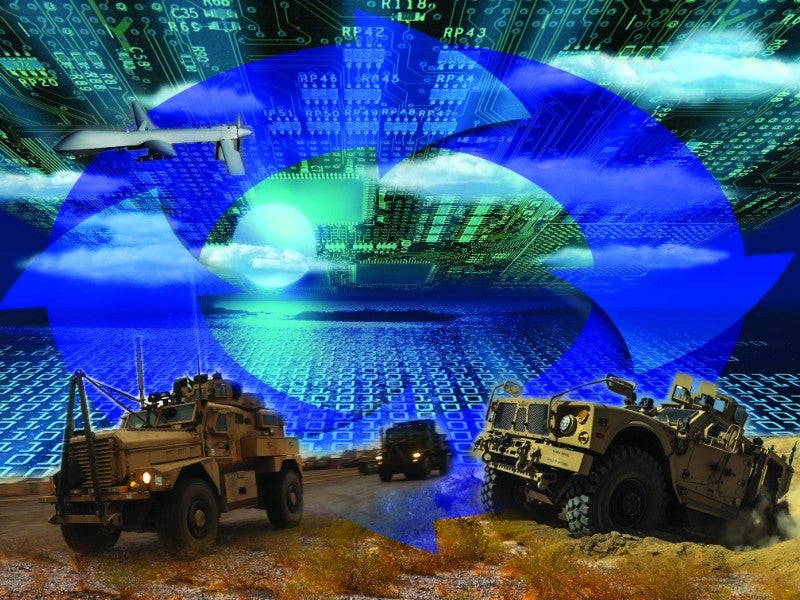
The US Army has recently stepped up its efforts to provide vital electronic warfare (EW) and cyber warfare support capabilities. For more than a decade, advances in electronic warfare have improved capabilities in areas such as communications, intelligence gathering, signal identification and jamming, and the operation of manned and unmanned weapons systems.
In December last year, the US Department of Defense (DoD) announced the $982m R4 indefinite delivery/indefinite quantity contract and is now issuing individual task orders to top defence companies to support the US Army’s full spectrum of cyber electromagnetic activities (CEMA), under the new Terrestrial Layer Intelligence System (TLIS), which integrates the old Multi-Functional Electronic Warfare Ground and Dismounted (MFEW) system with its Signals Intelligence enterprise.
So what exactly is the army looking for and which companies have offered their services thus far?
Three dimensions of EW: attack, protect, support
The US Army first addressed the requirement for advanced EW capabilities in its 2007 Electronic Warfare joint publication, which identifies three dimensions of EW.
The first is dedicated to the creation of new weaponry using electromagnetic, directed energy, or anti-radiation weapons to attack enemy personnel, facilities and equipment with the “intent of degrading, neutralising, or destroying enemy combat capability”. The second is simply the other side of coin – using EW to protect allied personnel and infrastructure from electronic attack.
The third dimension of EW is support, which helps soldiers to identify radiated electromagnetic energy and respond accordingly. It is this latter dimension that the US Army is really pushing to upgrade, according to spokesperson Cheryle Rivas.

US Tariffs are shifting - will you react or anticipate?
Don’t let policy changes catch you off guard. Stay proactive with real-time data and expert analysis.
By GlobalData“EW considerations are playing a complimentary and enabling role as we synchronise the development of various capabilities in line with the army’s modernisation strategy. Specifically, the army is looking to upgrade EW support,” Rivas says. “Also, as we modernise EW capabilities, we are enhancing the training and education programmes for soldiers performing operations within the EMS environment.”
The TLIS will be pivotal to maintaining the US’s competitive advantage in the EW field, according to the army.
Countering rival capabilities
Part of the need for greater EW support is due to the fact that Russia and China are beginning to develop advanced EW capabilities, and the US needs to stay competitive.
“The army faces a multitude of electronic warfare threats.” says Rivas. “They can range from systems that disrupt, deny, and/or deceive. With the proliferation of new technologies at an exponential rate, more systems are dependent on the electromagnetic spectrum to support operations. The army’s EW strategy directs and shapes how the army will grow and mature the capabilities and capacities within every warfighting formation.”
Russia’s EW capabilities have developed into a “formidable combat support asset”, according to International Center for Defence and Security research fellow Roger N McDermott in a report titled ‘Russia’s Electronic Warfare Capabilities to 2025’.
This was best evidenced in the Syrian conflict, where Russian forces used the Krasukha-4 vehicle-mounted EW system to jam small US surveillance drones, rendering them ‘blind and deaf’.
McDermott said of Russia’s recent military development: “There is nothing surprising that in the current circumstances, EW – as a relatively inexpensive and easily implemented means to disrupt the functioning of an enemy’s radar and other systems and to defend one’s own similar systems from interference – is emerging as a priority and a focus for development.”
China is also developing its EW capabilities and has released a doctrine promoting the use of electromagnetic spectrum weapons to suppress or deceive enemy equipment, according to the US DoD.
“People’s Liberation Army (PLA) EW units routinely conduct jamming and anti-jamming operations against multiple communication and radar systems and GPS satellite systems in force-on-force exercises,” the DoD said in its 2018 annual report to Congress on China’s military development.
“These not only test operational units’ understanding of EW weapons, equipment, and performance, but also help improve confidence in their ability to operate effectively in a complex electromagnetic environment.”
Seeking cyber assistance from industry
With regard to collaborating with industry, Rivas says: “The army works with all industry partners to provide a capability that meets emerging army requirements. Partnerships with industry are key to developing the technologies needed to defend our networks, data, and systems vital to delivering cutting-edge technologies to the force.”
One of the key partners on the R4 contract is Northrop Grumman. The US-based company is competing for orders spanning all EW areas, including research and technology development, integration support, laboratory demonstrations, integrated systems development, performance verification, logistics, technical support services, and cybersecurity.
Northrop Grumman Mission Systems vice-president for cyber and intelligence mission solutions Ginger Wierzbanowski said: “Our work on R4 will help ensure our army forces can rapidly identify, develop and leverage the full range of CEMA effects necessary to deter, deny and prevail on the battlefield.”
Another partner is General Dynamics Mission Systems (GDMS), which secured a spot on the R4 contract in March 2019. GDMS will work with the US Army to support EW modernisation efforts.
“The army must sustain its spectrum and cyberspace superiority to enable overmatch in every domain,” said General Dynamics Mission Systems vice-president and general manager Bill Patterson. “General Dynamics is making major investments to leverage our entire portfolio of electronic warfare and cyber capabilities to deliver the advantages needed by our Army customers in cyberspace.”
Specifically, GDMS will lead a US-wide team of cyber specialist companies to help boost cybersecurity through the integration of multiple technologies.
It remains to be seen which other companies will be contracted in to support the US’s new EW capabilities, but with plenty of work to be done within such a large ten-year contract on the table, many of the major defence firms and smaller tech firms will be eyeing potential EW support opportunities in the near future.



